The mood of a nation is a complex tapestry woven from threads of economic conditions, political events, societal changes, and global occurrences. Public opinion polls often serve as a tool to gauge this mood. But how accurate is the frequently asked poll question, “Would you say things in this country today are…?” Does it genuinely capture the nation’s sentiment, or do political loyalties sway it?
The inspiration for delving into this topic struck me during a recent visit to a coffee shop. As I sipped my cappuccino, I found myself engrossed in the latest Economist/YouGov poll. The more I read, the more it became glaringly evident: the question, “Is the country going in the right direction?” seemed synonymous with asking, “What is your political affiliation?” This observation led me to ponder: has this always been the case, and I’ve been oblivious to it? Or has there been a shift, causing the nation to become increasingly divided over its direction? The revelations from the poll were, to say the least, startling.
The primary aim of this article is multifaceted. We seek to dissect the results of the weekly poll from The Economist/YouGov, spanning various years, to understand the evolving sentiment of the American populace. While the data provides a snapshot, our objective extends beyond questioning the poll’s validity. We endeavor to delve into the underlying sentiments, emotions, and factors influencing public opinion, providing readers with a comprehensive understanding of the nation’s mood.
The Economist/YouGov, a reputable polling organization, has asked the public the same question since as early as 2009 and in each subsequent poll. Participants were asked: “Would you say things in this country today are…?” They could choose from three responses:
This question, while straightforward, provides a glimpse into the collective mindset of Americans, revealing more than just opinions on current events—it uncovers deeper feelings and beliefs about the nation’s future.
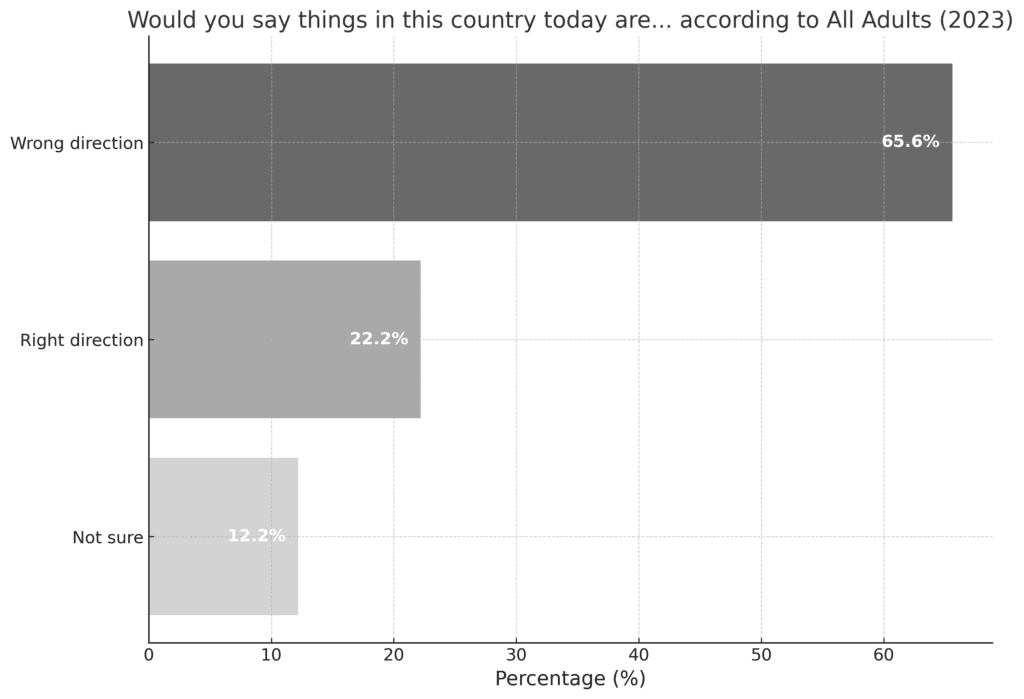
According to The Economist/YouGov Poll from August 26-29, 2023, 65.6% of those polled believe the U.S. is “off on the wrong track.” This sentiment is particularly pronounced among specific groups:
Conversely, only 22% feel the nation is “generally headed in the right direction.” This optimistic perspective is more prevalent among:
Diving deeper into the data offers further insight. Sentiments based on age indicate that the older age groups, particularly those aged 45-64, harbor a more robust sentiment that the country is off track. Insights from ethnic groups reveal that across all ethnicities, the sentiment predominantly leans towards the “wrong track.” When analyzed based on gender, the sentiments between men and women are strikingly similar, reinforcing the overarching sentiment across demographic lines.
While statistics offer a snapshot, it’s vital to understand the reasons behind these feelings. Economic conditions, policy decisions, global events, and crisis management strategies all play a role. For instance, the perceptual difference between urban and rural residents may be attributed to disparities in resource allocation or the outcomes of specific policies.
The data further reveals that the sentiment of the country’s direction varies noticeably based on education levels. College graduates and postgraduates generally displaya tighter convergence between the sentiments of the country moving in the right direction and those feeling it’s on the wrong track. This suggests a more balanced view or analytical approach to national events and policies among these groups. However, during the Trump Administration, a distinct shift occurred.
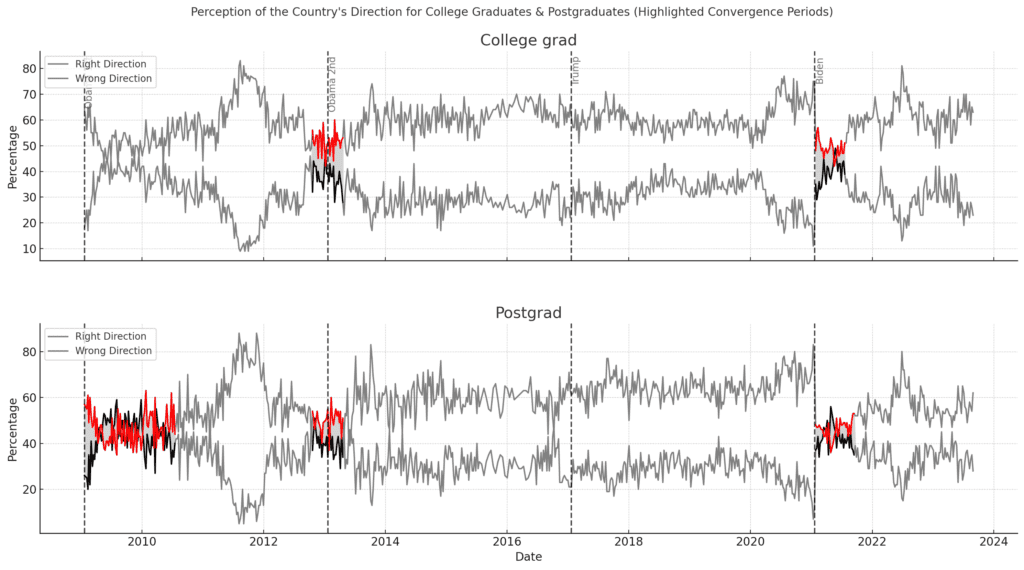
Those with some college education, and even more pronouncedly those with only a high school education or less, felt the country was moving in a more correct direction under Trump than during the Obama or Biden Administrations. This highlights the influence political administrations and their policies, or the portrayal of these policies in media and discourse, can have on specific demographic groups.
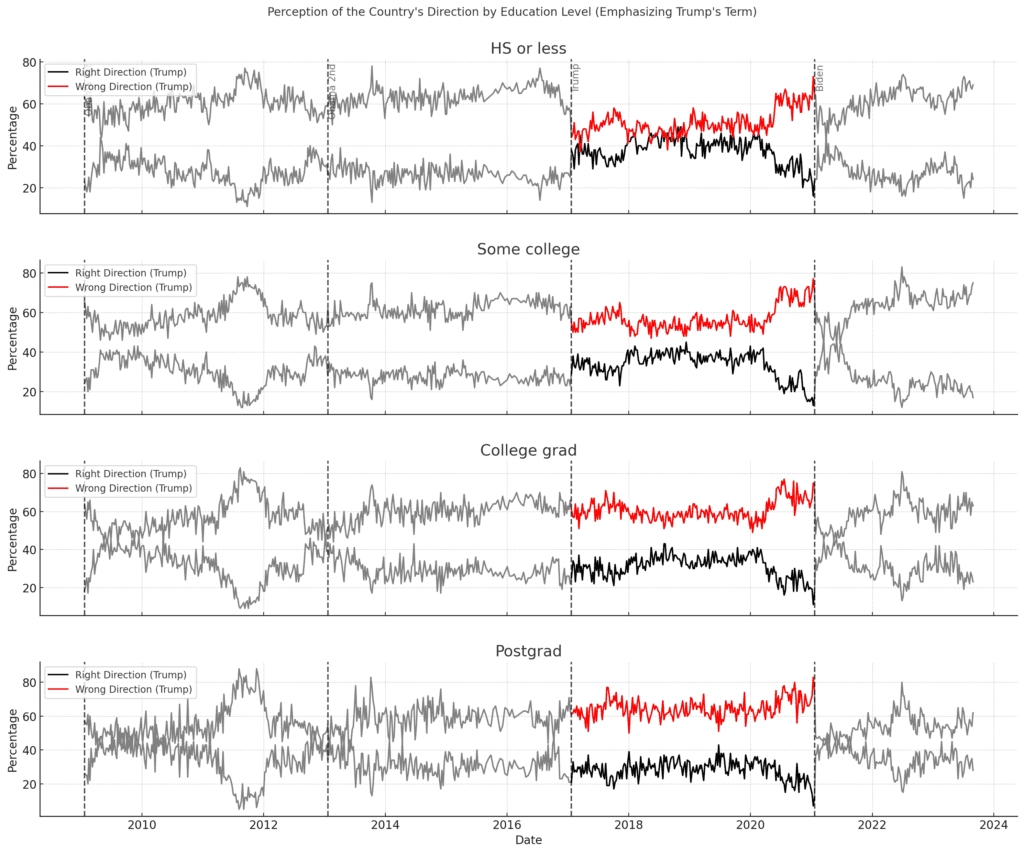
Moreover, the sharp divide in sentiments based on the 2020 presidential vote cannot be ignored. It underscores the heightened polarization in the U.S., with political loyalties potentially overshadowing other factors in influencing public sentiment. To truly understand this polarization, it’s imperative to delve into historical events and decisions, emphasizing the importance of learning from the past to decode the present.
While the data showcases a clear divide in sentiment based on political affiliation, one must ponder the depth of this alignment. Are these sentiments merely reflect party loyalty, or do they stem from deeper, individual beliefs? Historical events and studies have shown that political rhetoric, media influence, and peer circles significantly shape public opinion.
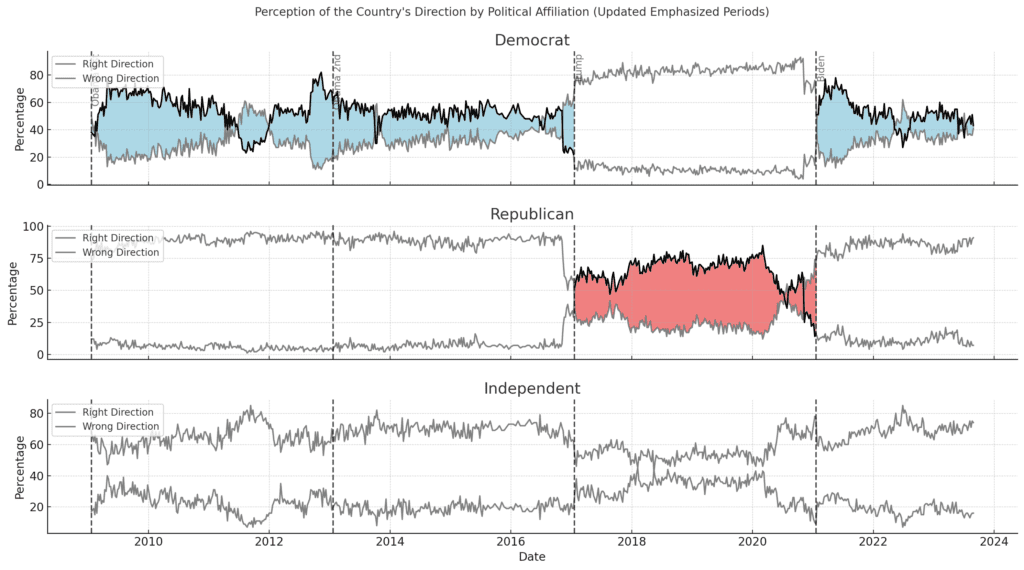
For instance, party narratives often dominate public discourse during election campaigns, potentially swaying individual sentiments. Furthermore, in an era of digital media, the echo chambers of social platforms can amplify party-aligned views, further entrenching individuals in their beliefs. It’s crucial to discern between genuine sentiment about the nation’s direction and opinions influenced by external factors.
To gain a deeper understanding of public sentiment over time, it’s useful to compare data from different years. The Economist/YouGov Poll from September 20-22, 2009, during President Obama’s tenure, offers a point of comparison.
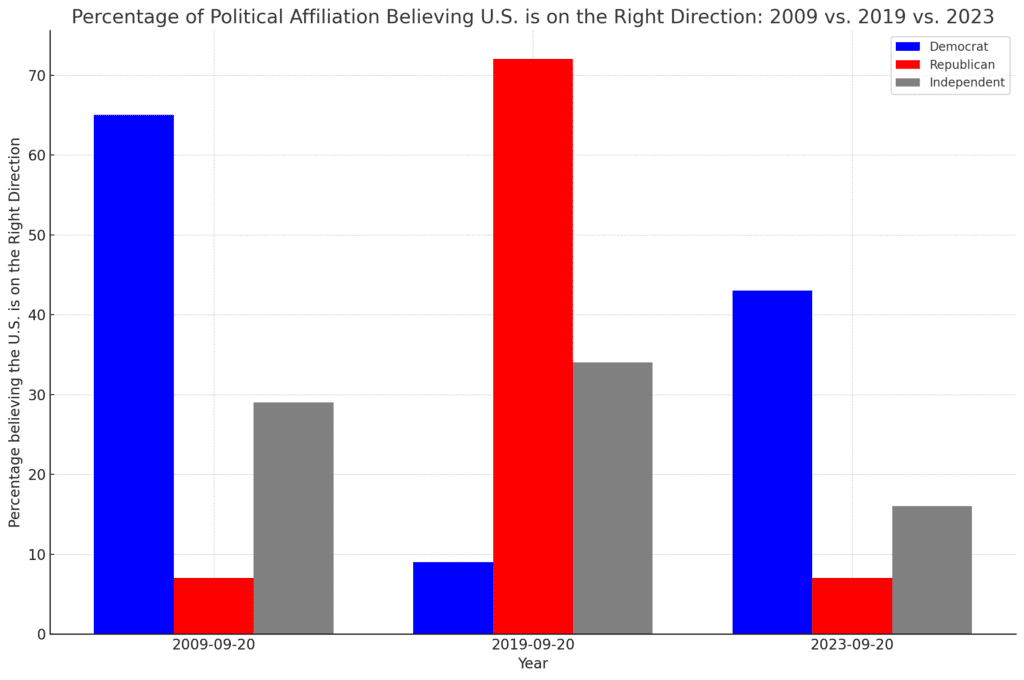
In 2009, 35.3% felt the U.S. was on the right path, while 51.1% believed it was on the wrong track. Interestingly, 65.4% of Democrats were optimistic about the nation’s direction, starkly contrasting to just 7.9% of Republicans. Comparing this data with figures from 2019 and 2023 reveals a consistent pattern: the party in power tends to view the country’s direction more favorably.
The ethnic breakdown of sentiments reveals some striking trends. During the Obama and Biden administrations, many Black Americans felt the country was moving in the right direction. This sentiment contrasts sharply with their feelings during the Trump administration, where the dominant sentiment was that the country was on the wrong track. Such fluctuations underscore the importance of representation and policies in shaping public sentiment.

In contrast, sentiments among White Americans were more varied, with no specific administration eliciting a dominant “right direction” sentiment. This difference highlights how sentiments about the nation’s trajectory can be deeply intertwined with issues of representation, policy impact, and perceptions of inclusivity.
There are notable moments in the data where sentiments of “right direction” and “wrong direction” come closest. These moments hint at times when the nation or specific demographic groups felt a sense of balance or reduced polarization. For instance, in 2011, among the “Under 30” group, the sentiments of “right direction” and “wrong direction” completely converged, suggesting a period of relative optimism or consensus.
While recent figures suggest a strong tie between political affiliation and poll responses, there have been moments in history when national sentiment went beyond party lines:
Addressing and navigating potential biases is paramount in presenting data and historical context. For instance, mentioning former President Trump’s legal challenges is not an attempt to sway opinion. Instead, it underscores significant events that might influence public trust and sentiment. In a broader context, such events, whether they concern political figures, institutions, or policies, can profoundly impact public sentiment. Recognizing and addressing these perceived biases ensures a balanced and comprehensive analysis, allowing readers to form informed opinions.
As revealed through polls, public sentiment is a multifaceted reflection of a nation’s pulse. Through this deep dive into the direction the U.S. is perceived to be headed, we’ve explored not only the prevailing sentiment but also its intricate ties to political affiliations, societal events, and education levels, among other factors.
The recurring theme is that political allegiance greatly influences perceptions about the country’s trajectory. While this is not entirely surprising, the depth of this alignment, particularly in recent years, is noteworthy. The sharp polarization, especially evident in the Trump era, suggests a deeply divided nation, with sentiments often shaped more by party loyalty than by objective national events and policy assessment.
However, the data also brings to light moments of convergence, suggesting periods of relative consensus or optimism. Although fleeting, these moments are a testament to the nation’s resilience and ability to come together during challenging times.
While polls provide a valuable snapshot, they are among many tools in understanding the nation’s mood. It’s crucial to approach them discerningly, recognizing the biases and the broader contexts that shape responses. After all, the mood of a nation is a tapestry, with every thread, every nuance, contributing to the larger picture. As we progress, it is essential to continuously seek a deeper understanding, ensuring that public opinion is informed, nuanced, and reflective of the nation’s true sentiment.